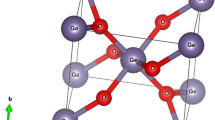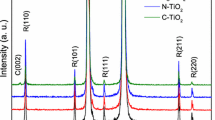Abstract
Magnetism sources of Fe doping and O vacancies, which coexist in the presence of rutile TiO2, are controversial and require a resolution. The effects of Fe doping and point defect on the magnetism of rutile TiO2 were studied using geometry optimization and energy calculation based on the first principle generalized gradient approximation + U method (GGA+U) of density functional theory. Fe/Vo ratio is 1:1 in rutile TiO2. The next closest distance between Fe and Vo is 0.04082 nm. The formation energy of the doping system is the smallest. This doping system has the highest stability. The coexistence of Fe doping and O vacancy achieved ferromagnetic long-range order. The different ratios of Fe/Vo are 1:1, 1:2, 2:1, and 2:2. The magnetic properties of the doping system are significantly different. At a ratio of 2:1, the magnetic moment is the largest among all doping systems. Moreover, the Curie temperature of the doping system can be higher than room temperature. These findings can obtain dilute magnetic semiconductors with potential application value. At a Fe/VO ratio of 2:2, the Ti14Fe2O30 system produces a half-metallic property of 100% electron spin polarizability. This is the most valuable application for designing and preparing novel spintronic injection source dilute magnetic semiconductors. The magnetic source is mainly mediated by the holes generated by Fe doping and O vacancy complexes, thereby causing the spin polarization double exchange effect on the electron of Ti–3d orbital atoms near the O vacancy, O–2p electron orbital, and Fe–3d electron orbital. This feature is consistent with the following theories: the mean field approximation and the double exchange mechanism theories.




Similar content being viewed by others
References
Wang, X., Song, Y., Tao, L.L.: Origin of ferromagnetism in aluminum-doped TiO2 thin films: theory and experiments. Appl. Phys. Lett. 105, 262402 (2014)
Matsumoto, Y., Murakami, M., Shono, T.: Room-temperature ferromagnetismin transparent transition metal-doped titanium dioxide. Science. 291, 854–856 (2001)
Zarhri, Z., Houmad, M., Ziat, Y.: Ab-initio study of magnetism behavior in TiO2 semiconductor with structural defects. J. Magn. Magn. Mater. 406, 212–216 (2016)
Xu, N.N., Li, G.P., Lin, Q.L.: Structural and magnetic study of undoped and Cu-doped rutile TiO2 single crystals. J. Supercond. Nov. M. 30, 2591–2596 (2017)
Thu, D.X., Trung, V.Q., Nghia, N.M.: Effects of Fe doping on the structural, optical, and magnetic properties of TiO2 nanoparticles. J. Electron. Mater. 45(11), 6033–6037 (2016)
Yang, S., Jiang, D., Zeng, Q.: Room temperature ferromagnetism of Fe-doped and (Fe, Cu)-codoped TiO2 powders prepared by mechanical alloying. J. Mater. Sci. 6, 6570–6577 (2016)
Akdogan, N., Nefedov, A.H., Zabel, K., Westerholt, H.: High-temperature ferromagnetism in Co-implanted TiO2 rutile. J. Phys. D. Appl. Phys. 42(11), 115005 (2009)
Ahmed, S.A.: Ferromagnetism in Cr-, Fe-, and Ni-doped TiO2 samples. J. Magn. Magn. Mater. 442, 152–157 (2017)
Zou, Z., Zhou, Z., Wang, H.: Oxygen defect-mediated magnetism in Fe-C Co doped TiO2. Adv. Mater. Sci. Eng. 11, 1–7 (2016)
Waseem, S., Anjum, S., Mustafa, L.: Effects of Fe and Co co-doping on structural, magnetic, sand optical properties of Ti0.9Fe0.1xCoxO2 magnetic semiconductors. J. Supercond. Nov. Magn. 57, 103002–103005 (2018)
Mudarra, Navarro, A.M., Rodríguez, T., Claudia, E., Bilovol, V.: Study of the relation between oxygen vacancies and ferromagnetism in Fe-doped TiO2 nano-powders. J. Appl. Phys. 14, 223908 (2014)
Meng, H.J., Hou, D.L., Jia, X.J.: Role of oxygen vacancies on ferromagnetism in Fe-doped TiO2 thin films. J. Appl. Phys. 102, 073905 (2007)
Li, J.P., Meng, S.H., Qin, L.Y.: Optical properties of anatase and rutile TiO2 studied by GGA+U. Chin. Phys B. 26, 087101 (2017)
Hsuan, C.W., Sheng, H.L., Syuan, W.L.: Effect of Fe concentration on Fe-doped anatase TiO2 from GGA +U calculations. Int. J. Photoenergy. 2, 91–98 (2012)
Atanelov, J., Gruber, C., Mohn, P.: The electronic and magnetic structure of p-element (C,N) doped rutile-TiO2; a hybrid DFT study. Comput. Mater. Sci. 98, 42–50 (2015)
Bader, R.F.W.: The International Series of Monographs on Chemistry. Oxford University, Oxford (1990)
Liu, B., Zhao, X.: The synergetic effect of V and Fe-co-doping in TiO2, studied from the DFT + U first-principle calculation. Appl. Surf. Sci. 399, 654–662 (2017)
Wang, Y., Ma, J., Zhou, J.P.: First-principles study of the electronic structure of nonmetal-doped anatase TiO2. J. Korean Phys. Soc. 68, 409–414 (2016)
Xin, L., Quan, X., Zean, T.: A DFT study of electronic structures and optical properties of nickel, nitrogen doped rutile TiO2. Chem. Phys. Lett. 710, 143–146 (2018)
Fisher, C.A.J., Prieto, V.M.H., Islam, M.S.: Lithium battery materials LiMPO4 (M = Mn, Fe, Co, and Ni): insights into defect association, transport mechanisms, and doping behavior. Chem. Mater. 20, 5907–5915 (2008)
Zhang, S., Zhou, Z., Xiong, R.: The origin of ferromagnetism of Co-doped TiO2, nanoparticles: experiments and theory investigation. Mod. Phys. Lett. B. 30, 1650296 (2016)
Liu, H., Zhang, J.M.: Effect of two identical 3d transition-metal atoms M doping (M = V, Cr, Mn, Fe, Co, and Ni) on the structural, electronic, and magnetic properties of ZnO. Phys. Status. Solidi. B. 254, 1700098 (2017)
Fakhim, L.A., Ouchri, M., Belaiche, M.: The effect of fluorine doping on electronic structure and ferromagnetic stability of Os-doped TiO2 rutile phase: first-principles calculations. J. Magn. Ater. 401, 977–981 (2016)
Dietl, T., Ohno, H., Matsukura, F., Cibert, J., Ferrand, D.: Zener model description of ferromagnetism in zinc-blende magnetic semiconductors. Science. 287, 1019–1022 (2000)
Sato, K., Katayama-Yoshida, H.: Material design fortransparent ferromagnets with ZnO-based magnetic semiconductors. Jpn. J. Appl. Phys. 39, L555–L558 (2000)
Sato, K., Dederics, P.H., Katayama-Yoshida, Y.H.: Curie temperatures of III–V diluted magnetic semiconductors calculated from first principles. Europhys. Lett. 61, 403–408 (2003)
Pan, F.C., Lin, X.L., H.M., C., Guo, Y.R., Wang, X.M.: Ferromagnetism of Cu-doped anatase TiO2: the first-principles calculation study. Jpn. J. Appl. Phys. 57, 103002 (2018)
Funding
This work was supported by the National Natural Science Foundation of China (Grant Nos. 61366008, 61664007) and Technology Major Project of Inner Mongolia Autonomous Region (2018-810).
Author information
Authors and Affiliations
Corresponding author
Additional information
Publisher’s Note
Springer Nature remains neutral with regard to jurisdictional claims in published maps and institutional affiliations.
Rights and permissions
About this article
Cite this article
Xia, D., Hou, Q. & Guan, Y. Effect of Fe Doping and O Vacancies on the Magnetic Properties of Rutile TiO2. J Supercond Nov Magn 32, 3615–3621 (2019). https://doi.org/10.1007/s10948-019-5129-x
Received:
Accepted:
Published:
Issue Date:
DOI: https://doi.org/10.1007/s10948-019-5129-x




